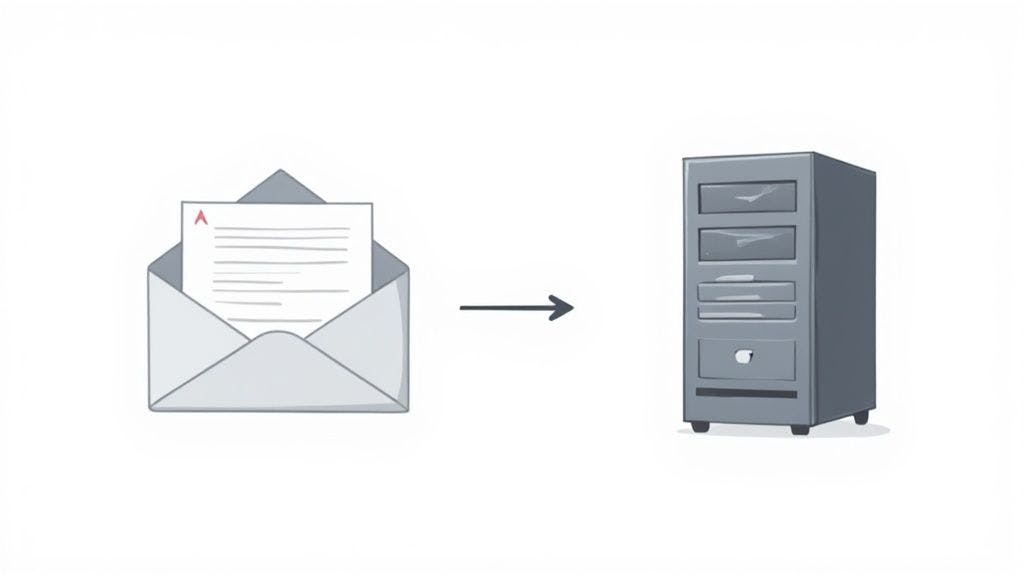Why Email Validation In Python Matters More Than You Think

Email validation in Python is a critical aspect of maintaining the health and efficiency of any application handling user data. It goes beyond simply checking for the "@" symbol and a ".com". Properly validating email addresses protects your application in several ways, impacting deliverability, security, and overall user experience.
The Hidden Costs of Poor Email Validation
Without robust email validation, you risk a cascade of negative consequences. Sending emails to invalid addresses harms your sender reputation, increasing the likelihood of future emails ending up in spam folders. It also opens the door to fraudulent registrations, potentially exposing your application to spam and malicious activity. Most importantly, your legitimate messages won't reach their intended audience, hindering communication and wasting valuable resources. Understanding the benefits of email validation is paramount. For a deeper dive into this topic, see why verifying your email list is important.
Levels of Email Validation in Python
Effective email validation employs a multi-layered approach, each layer adding a degree of certainty:
- Syntax Validation: This fundamental step ensures the email address conforms to the standard format (e.g., [email protected]), catching obvious typos and improperly formatted addresses.
- Domain Verification: This level confirms the existence of the domain portion of the email address, preventing emails from being sent to nonexistent domains.
- Mailbox Verification: This is the most comprehensive check, verifying that an actual mailbox exists for the provided email address at the given domain. It often involves connecting to the mail server.
This tiered approach allows you to select the appropriate validation level to suit your needs. The history of Python-based email validation tools mirrors the growth of email communication. The email-validator Python package, available since at least Python 3.8, demonstrates this by providing a robust solution for checking email syntax and deliverability. By 2024, this library gained significant traction, highlighting its widespread adoption. Explore this topic further.
You might also find this helpful: How to master email deliverability. Robust email validation in Python is a worthwhile investment for long-term success. It protects your application’s reputation, minimizes wasted resources, and ensures your messages reach real users. This ultimately leads to a better user experience, improved marketing ROI, and a more secure and reliable application.
Crafting Bulletproof Regex Patterns That Actually Work
Regular expressions (regex) are fundamental to email validation in Python. However, crafting effective regex for this purpose requires a delicate balance. Too permissive, and invalid emails slip through. Too restrictive, and legitimate addresses get rejected. The key is finding the sweet spot between catching common errors and accommodating the diverse range of valid email structures.
Understanding Regex Fundamentals for Email Validation
A widespread approach to email validation in Python uses regex, a staple since the early days of Python email handling tutorials. A typical regex pattern confirms an email starts with one or more alphanumeric characters, periods, or hyphens, followed by an "@" symbol. It then checks for a valid domain name with letters, numbers, or hyphens, ending in a suffix of at least two letters. This efficiently catches basic syntax errors but doesn't verify the actual existence of the mailbox or domain. Learn more about validating emails with regex. Understanding the core principles of data validation is crucial. For more insights, explore this guide on data validation best practices.
Handling Tricky Email Formats With Regex
While the basic regex approach provides a good foundation, it often struggles with more complex emails. Internationalized domain names, plus signs in local parts, and other less common yet valid formats can easily trip up simpler patterns. This underscores the need for more robust regex patterns in Python. For instance, accommodating international characters requires careful consideration within the regex pattern itself.
Why the 'Perfect' Email Regex Doesn't Exist
It's essential to recognize that a single, universally perfect regex for email validation is a myth. The official email specification is remarkably complex, allowing for various characters and structures that often surprise developers. Attempting to capture every valid email format with regex results in incredibly long, difficult-to-maintain patterns that may still prove imperfect.
Practical Regex Strategies for Email Validation in Python
So, how do you build effective regex for email validation in Python? The answer lies in balancing practicality and accuracy. Begin with a solid base pattern that addresses common mistakes and refine it based on your specific needs and expected email types.
Here are some best practices:
- Start simple: Begin with a basic regex pattern and gradually introduce complexity as needed.
- Test thoroughly: Utilize a wide range of test emails, both valid and invalid, to validate your pattern's performance.
- Consider edge cases: Account for international characters, unusual domain extensions, and other uncommon but valid formats.
- Don't over-optimize: A slightly less precise but readable and maintainable regex is often preferable to an overly complex one.
By combining a well-crafted regex pattern with other validation methods, you can develop a robust and efficient email validation system in Python, enhancing user experience and application reliability.

Choosing The Right Python Email Validation Library
Not all Python email validation libraries are created equal. Selecting the right one can significantly impact the accuracy and performance of your validation process. A poor choice could lead to wasted resources and frustrated users. Therefore, understanding each library’s strengths and weaknesses is crucial.
Exploring Popular Python Email Validation Libraries
Python offers several libraries for email validation, each with its own approach and features. Some rely on simple regex-based validation, while others perform comprehensive checks, including DNS and SMTP verification. Knowing these differences is key to selecting the best tool for your specific project. Learn more in our article about what is email verification.
- email-validator: This library performs syntax checks and also verifies domain existence. It also supports internationalized email addresses, providing a balance of simplicity and robust functionality. It’s a solid choice for many applications.
- validate_email: validate_email provides syntax validation and optional DNS and SMTP checks. Its flexible design lets developers customize the validation process to fit their exact requirements.
- py3-validate-email: This library prioritizes speed and efficiency, using regular expressions for fast validation. It also includes disposable email detection, making it suitable for high-volume validation tasks.
Comparing Library Features and Performance
To help you choose, the table below compares these popular Python email validation libraries based on key features, performance, and recommended use cases.
Python Email Validation Libraries Comparison: Comparing popular Python email validation libraries by features, performance, and use cases.
Library | Syntax Check | Domain Verification | Performance | Best Use Case |
|---|---|---|---|---|
| Yes | Yes | Good | General-purpose validation, international emails |
| Yes | Optional | Moderate | Flexible validation with customizable checks |
| Yes | Limited | Fast | High-volume validation, disposable email detection |
Key insights from the comparison reveal that email-validator offers a balanced approach, validate_email shines in flexibility, while py3-validate-email prioritizes speed.
The infographic below visualizes the capabilities of Python's standard email module.

The email module excels at header parsing and adheres to RFC 5322 standards, ensuring compliance with email formatting rules. However, its Unicode address support is limited. Choosing the right library depends on balancing features, performance, and your project’s needs.
Integrating and Managing Email Validation
No matter which library you choose, proper integration and error handling are essential for a positive user experience. Clear error messages help users correct invalid email addresses. Implement strategies for handling validation failures gracefully, without interrupting user flow. By considering these factors, you can build robust and user-friendly email validation systems in Python. This improves user satisfaction and protects your applications.
Building Enterprise-Grade Validation Systems
Building robust email validation systems, especially for enterprise-level applications, goes beyond simple regex and Python libraries. When data integrity and high email traffic volumes are critical, a more sophisticated approach is necessary. This section explores the three-tier validation strategy employed by industry leaders to maximize accuracy and efficiency.
Implementing a Three-Tier Validation Approach
Robust email validation involves three key tiers:
- Syntax Checking: The first layer utilizes regex and libraries like email-validator to quickly identify and filter out improperly formatted email addresses. This ensures only valid email formats proceed to subsequent validation stages.
- DNS Verification: The second layer verifies the Domain Name System (DNS) records associated with the email domain. This step confirms the domain's existence and detects potential problems, such as missing or incorrect MX records that could hinder email delivery.
- SMTP Validation: This is the most thorough validation step, establishing a direct connection with the SMTP server. This not only verifies the domain but also confirms the existence of the specific mailbox, ensuring the email address can receive messages. This process significantly reduces bounce rates, a critical performance metric for businesses reliant on email communication.
Balancing Validation Thoroughness and User Experience
While comprehensive validation is essential, maintaining a positive user experience is equally important. Overly aggressive or slow validation processes can frustrate users, leading to form abandonment. A strategic approach to validation timing and user feedback is key. For example, real-time syntax feedback during user input enhances the experience without the performance cost of running a full SMTP check with each keystroke.
Handling Edge Cases and Maintaining Validation Accuracy
Email validation in practice encounters numerous edge cases. Temporary email addresses, internationalized domains, and role-based emails (like info@ or sales@) each pose unique validation challenges. Enterprise-grade systems must handle these scenarios gracefully to minimize both false positives and false negatives. Furthermore, email validation is vital for email marketing, extending beyond simple syntax. Businesses with bounce rates exceeding 2% risk being flagged as spam by Internet Service Providers (ISPs), damaging their sender reputation. Robust Python email validation has proven to reduce bounce rates by up to 70%, safeguarding sender reputation and improving deliverability. Learn more about the relationship between validation and bounce rates at Discover more insights about email validation and bounce rates.
Monitoring and Adapting to Evolving Email Landscape Requirements
The email landscape is dynamic. New top-level domains (TLDs) constantly emerge, email providers update their policies, and spam filtering techniques evolve. Therefore, enterprise-grade email validation systems must be adaptable. Regular monitoring of validation accuracy, bounce rates, and feedback from email service providers is essential. This allows for the identification of emerging trends and adaptation of validation strategies to maintain long-term effectiveness, prevent deliverability problems, and avoid wasted resources.
Real-Time Validation Without Breaking User Experience

Modern web users expect instant feedback, especially with form validation. Building real-time email validation in Python requires careful design. A poorly implemented system can lead to slow, unresponsive forms and frustrated users. This section explores building real-time email validation that delivers instant feedback without sacrificing performance or usability.
Building Responsive Validation Systems
The key to a seamless user experience is optimizing the validation process for speed and efficiency. Often, this means building dedicated validation APIs designed for frequent requests with sub-second response times. This approach allows for immediate feedback as the user types, minimizing any noticeable lag.
Implementing Caching and Rate Limiting
Imagine a user repeatedly trying variations of an email address. Without caching, each attempt triggers a new validation request, potentially overloading your system. Caching previous results drastically reduces load and improves response times. Adding rate limiting prevents abuse and protects your API from excessive requests.
To illustrate the benefits of these various optimizations, let's look at some typical response times for various email validation approaches:
Introduction to Validation Response Time Benchmarks: The following table showcases a comparison of different validation techniques and their performance characteristics, highlighting the impact of strategies like caching and rate-limiting.
Validation Method | Average Response Time | Throughput | Accuracy Level | Resource Usage |
|---|---|---|---|---|
Basic Regex (no caching) | 50ms | 20 requests/sec | Low | Low |
Regex with Caching | 5ms | 200 requests/sec | Low | Medium |
DNS Verification (no caching) | 500ms | 2 requests/sec | High | High |
DNS Verification with Caching and Rate Limiting | 50ms | 20 requests/sec | High | Medium |
API Call (external service) | 200ms | 5 requests/sec | Medium | Low |
Key Insights: As you can see, caching significantly improves response times, especially for more complex validation methods like DNS verification. Rate limiting allows for sustained performance even under heavy load while maintaining a high level of accuracy. Simple regex checks, even with caching, offer the fastest response times but compromise on accuracy.
Providing Meaningful Error Messages
Real-time validation involves more than just "valid" or "invalid" responses. Meaningful error messages help users correct mistakes quickly. Instead of "invalid email," provide specific feedback like "missing @ symbol" or "invalid domain format." This guidance improves the user experience.
Progressive Validation: Balancing Speed and Accuracy
Progressive validation starts with basic syntax checks and gradually increases the validation's thoroughness as the user types. This provides quick initial feedback without performing full validation on every keystroke. A quick regex check can instantly flag missing characters. A more intensive DNS verification can run after a pause or when the user exits the field. This dynamic approach balances speed with the need for accurate email validation in Python.
Avoiding Common Validation Mistakes That Kill Conversions
Even experienced Python developers sometimes stumble over email validation pitfalls. These mistakes can negatively impact user experience and, ultimately, your conversions. They range from overly strict rules to inadequate error handling, frustrating users and potentially driving them away. Let's explore some common mistakes and how to avoid them.
Overly Restrictive Validation: Rejecting Valid Emails
One frequent mistake is using overly restrictive regex patterns. While striving for precision is commendable, overly strict patterns can reject perfectly valid email addresses, particularly international ones. For instance, some patterns might not include all valid top-level domains (TLDs) or recognize legitimate characters used in other countries. This can lead to lost leads and missed opportunities.
Insufficient Error Handling: Leaving Users Confused
Imagine entering your email address only to see "Invalid Email." What went wrong? Vague error messages leave users guessing. Instead, provide specific guidance. For example, explain if the "@" symbol is missing, the domain is invalid, or a typo is suspected. Clear error messages empower users to correct their input and complete the conversion. Check out our guide on what a bounce is in email marketing for more context on the impact of incorrect emails.
Ignoring International Email Formats
The internet is global. Ignoring international email formats is a significant oversight. Some email addresses may contain non-ASCII characters or use different TLDs. Not accommodating these variations can alienate a substantial portion of your potential audience. Ensure your Python email validation handles these nuances.
Neglecting Security and Privacy
Email validation plays a vital security role. Improper input sanitization can create vulnerabilities. For example, failing to escape special characters can open the door to cross-site scripting (XSS) attacks. Also, ensure compliance with data privacy regulations concerning the storage and handling of email addresses.
Poor Performance: Slowing Down Conversions
Slow validation processes can create a frustrating user experience. Users are likely to abandon slow forms. Implement efficient validation methods, such as caching and asynchronous validation, to avoid performance bottlenecks and keep conversions flowing.
Testing With Edge Cases: Revealing Hidden Problems
Finally, rigorous testing is essential. Don't just test with common email formats. Use a diverse set of test cases, including unusual but valid email addresses, international formats, and edge cases. This can reveal hidden flaws and ensure robust and reliable email validation in Python. By avoiding these common mistakes and adopting best practices, you can build email validation systems that protect your application, enhance user experience, and boost conversions.
Key Takeaways
Email validation in Python is essential for any application involving user interaction. This section offers practical advice for creating a robust and scalable email validation system, highlighting the key elements for success.
Choosing the Right Validation Approach
- Start with Syntax: Begin by checking basic syntax using regular expressions or a library like email-validator. This catches obvious typos and formatting issues, efficiently filtering out invalid addresses.
- Domain Verification for Added Confidence: Enhance validation by verifying the email's domain. This confirms the domain actually exists, increasing confidence in the address's validity.
- SMTP Verification for Maximum Accuracy: For the highest accuracy, use SMTP verification. This confirms the mailbox exists and is capable of receiving emails, significantly reducing bounce rates.
Implement Effective Testing Strategies
- Test Early and Often: Integrate testing throughout your development process. This allows you to catch problems early, preventing them from escalating into larger issues.
- Use a Variety of Test Cases: Test with both valid and invalid email addresses, including edge cases. Examples include international formats, long addresses, and unusual characters.
- Monitor and Adapt: Regularly examine validation results and bounce rates. Email standards change, so adapting your system is critical.
Monitoring System Performance and Scalability
- Real-Time Validation Best Practices: Provide real-time feedback to users while keeping performance in mind. Employ caching and rate limiting to maintain fast response times.
- Error Handling is Crucial: Use clear error messages to explain why an email is invalid. This helps users correct their input easily.
- Progressive Validation for Smooth UX: Consider progressive validation. Start with basic syntax checks and progress to more in-depth verification as the user completes the form. This approach balances quick feedback with accuracy and a smooth user experience.
By implementing these takeaways, you can develop efficient, scalable, and accurate email validation in Python. This safeguards your application and enhances the user experience.
Ready to improve your email validation? Try VerifyRight and see the benefits of a robust and dependable system. Start validating with VerifyRight!

